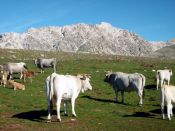Campo Imperatore: the pastures
Campo Imperatore is of tectonic origin and its morphology is shaped by floods and especially by glaciers, by snow and periglacial phenomena. It is still possible to see the moraines in the bottom, sideways and in front of the glacier, that fifteen years ago was the biggest one in the Apennines. The upland's vegetation only consists of grasses: the exposed and central position of the massif make this area's climate continental, cold in winter and cool in summer, almost dry in the summits and peaks. It has very different characteristics depending on morphology, wind and snow level: the small valleys are quiet wet and feature rare plant species of northern origin, while the moraines and the peaks have a typical steppe-like vegetation of eastern origin. Typical fetatures of such environments are the "Fiumare", that is gravel expanses coming down to the thaw areas from the deep clefts of Brancastello and Mount Prena, where it is possible to observe plants which usually grow at higher altitudes, and interesting endemic species as well.
The wide pastures, which have been always used as summer mountain pastures for the herds of sheep, cattle and horses, are characterized by the presence of true grasses such as fescues, moor grasses, timothy-grass, common wild oat, matgrass. In the "fiumare" the most common plants are the italian stock (Matthiola italica), that is an endemic plant with violet or yellow flowers and light-green leaves, the mountain avens (Dryas octopetala) which is a polar symbol after which the last cold period of the past ice ages was named, namely the "Younger Dryas". Other plants are the blue moor grass (Sesleria caerulea), a very rare species existing only in this area of the Apennines, and the Ononis cristata, an apennine subspecies, endemic plant of the central Apennines.

Grazing cattle